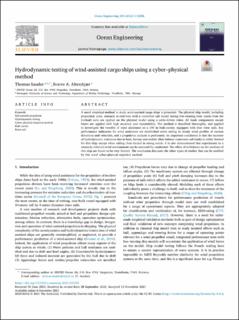| dc.contributor.author | Sauder, Thomas Michel | |
| dc.contributor.author | Alterskjær, Sverre Anders | |
| dc.date.accessioned | 2022-05-03T07:57:29Z | |
| dc.date.available | 2022-05-03T07:57:29Z | |
| dc.date.created | 2022-01-13T08:26:25Z | |
| dc.date.issued | 2021 | |
| dc.identifier.citation | Ocean Engineering. 2021, 243, 110206, 16. | en_US |
| dc.identifier.issn | 0029-8018 | |
| dc.identifier.uri | https://hdl.handle.net/11250/2993764 | |
| dc.description.abstract | A novel empirical method to study wind-assisted cargo ships is presented. The physical ship model, including propulsion units, interacts in real-time with a numerical sail model during free-running tests. Loads from the (virtual) sails are applied on the physical model using a cable-driven robot. All loads components except heave are applied with high accuracy and repeatability. The method is described thoroughly, and applied to investigate the benefits of wind assistance on a 190 m bulk-carrier, equipped with four rotor sails. Key performance indicators for wind assistance are established when sailing in steady wind profiles of various directions and velocities, and a propulsion analysis is performed. An important conclusion is that the increase of hydrodynamic resistance due to heel, leeway and rudder (that balance transverse sail loads) is rather limited for this ship, except when sailing close-hauled in strong winds. It is also demonstrated that experiments in a unsteady (virtual) wind environment can be successfully conducted. The effect of turbulence on the motions of this ship are found to be very limited. The conclusion discusses the other types of studies that can be enabled by this novel cyber–physical empirical method. | en_US |
| dc.language.iso | eng | en_US |
| dc.publisher | Elsevier | en_US |
| dc.rights | Navngivelse 4.0 Internasjonal | * |
| dc.rights.uri | http://creativecommons.org/licenses/by/4.0/deed.no | * |
| dc.title | Hydrodynamic testing of wind-assisted cargo ships using a cyber–physical method | en_US |
| dc.title.alternative | Hydrodynamic testing of wind-assisted cargo ships using a cyber–physical method | en_US |
| dc.type | Peer reviewed | en_US |
| dc.type | Journal article | en_US |
| dc.description.version | publishedVersion | en_US |
| dc.rights.holder | © 2021 The Author(s). Published by Elsevier Ltd | en_US |
| dc.source.pagenumber | 16 | en_US |
| dc.source.volume | 243 | en_US |
| dc.source.journal | Ocean Engineering | en_US |
| dc.identifier.doi | 10.1016/j.oceaneng.2021.110206 | |
| dc.identifier.cristin | 1980050 | |
| dc.relation.project | Norges forskningsråd: 237917 | en_US |
| dc.relation.project | Norges forskningsråd:194068 | en_US |
| dc.source.articlenumber | 110206 | en_US |
| cristin.ispublished | true | |
| cristin.fulltext | original | |
| cristin.qualitycode | 1 | |

